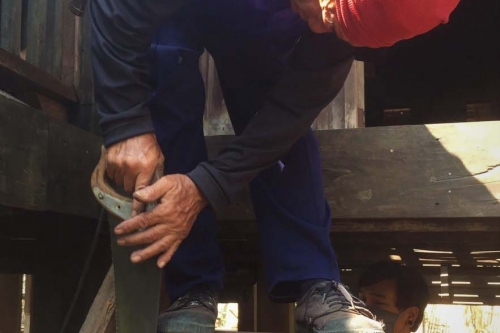ลมหายใจของการอนุรักษ์ เรือนโบราณสันป่าตอง 2 (แม่ครูทองสาย เล็กตระกูล) - The Breath of Conservation Sanpatong Folk House 2, Mae Kru Tongsai Lektragoon
แม่ครูทองสาย เล็กตระกูล เป็นผู้ดูแลเรือนโบราณหลังนี้ร่วมกับน้องสาวอีกสองคน เรือนหลังนี้สร้างขึ้นเมื่อ พ.ศ.2483 โดยพ่ออุ๊ยปัน แม่อุ๊ยคำ ก้อนแก้ว
I’m Mae Kru Thongsai Lektragoon. I take care of this traditional house along with my two younger sisters. This house was built in 1940 (Buddhist Era 2483).
เมื่อสมัยก่อนใต้ถุนบ้านจะเป็นใต้ถุนโล่ง เอาไว้สำหรับเลี้ยงวัวควาย เนื่องจากประกอบอาชีพทำไร่ ทำนา และแม่อุ๊ยก็เอาไว้ทอผ้า มีกี่สำหรับทอผ้าใต้ถุนบ้าน
In the past, the space under the house was empty and was used to keep cows and buffalo because the owners were farmers. My grandmother used this space to weave cloth. There was a loom in that space as well.
พ่ออุ๊ยปันกับแม่อุ๊ยคำจะเป็นครอบครัวใหญ่ ก็จะแยกกันไปสร้างบ้านสร้างฐานะกันออกไป และบ้านหลังนี้จะมีห้องโล่งบริเวณหน้าบ้านคือเติ๋น ที่พักบันได เวลาแขกมาก็จะมานั่งพักบริเวณนี้
My grandfather and grandmother had a large family, and they scattered around and built houses for their families. There is an empty room towards the front of the house, which is the terrace at top of the stairs. When guests come, they sit in this area.
เติ๋นนี้ ก็จะใช้เวลามีกิจกรรม เช่น งานบุญ ก็จะมาอยู่รวมกันบริเวณเติ๋น สมัยก่อนมีงานสลาก งานปอยหลวง ก็จะใช้รับแขก ถ้ามีงานใหญ่ก็จะเปิดหน้าบ้าน เพราะตามปกติจะปิด ด้านบนนี้มีสองห้องนอน และไม่มีห้องน้ำด้านบนเรือน และมีอีกหนึ่งห้องคือห้องครัว
The terrace is also used for events and ceremonies. The guests will gather here. In the past there were large Buddhist ceremonies, and all of the guests would be here. If it was particularly big, they would open the front of the house. But usually it stayed closed. Up here there are two bedrooms and a bathroom. There’s also a kitchen.
สมัยก่อนมีแขกมาพักนอน ก็จะนอนกันที่เติ๋นนี้ รับแขกบนเติ๋นนี้ ไม่เอาเข้าห้องนอน บ้านหลังนี้จะมีสองห้อง ห้องนี้เป็นห้องนอนของพ่อแม่ และส่วนอีกห้องนี้เป็นห้องนอนของพวกลูกหลาน ก็สามารถอยู่ได้โดยไม่ต้องทำเพิ่มแล้ว เพราะว่าตอนแรกเป็นครอบครัวใหญ่ จากนั้นก็แยกออกไปเหลืออยู่บ้านหลังนี้สองสามคน ทางเดินตรงนี้นำไปสู่ด้านหลัง ในสมัยก่อนไม่มีประตูตรงนี้ แต่สมัยนี้ต้องมีความปลอดภัยสูงจึงต้องมีการสร้างประตูขึ้นภายหลัง
In the past, guests would stay here and would sleep in the terrace. They would not stay in the bedrooms. This house has only two bedrooms, one for the parents and one for the children, so it was easy to live together without adding any more rooms. At first, they were going to have a large family, but the children started to move away and there were only a few people left to live in this house. This walkway will take you to the back. In the past there was no door here, but a door was built for greater security.
อันนี้เป็นห้องโล่งๆ เรียกว่าเติ๋น เติ๋นหลังบ้าน เอาไว้ยามมีกิจกรรมทำบุญ ที่ญาติพี่น้องมาพบกัน ชุมนุมกันหลายๆ คน
This empty room is another terrace, or ‘tern’ in Lanna language. The back terrace. It is for making merit rituals that bring the extended family together.
ส่วนนั้น ได้ทำการปรับปรุงในปี พ.ศ.2545 เนื่องจากเป็นชานโล่งตากฝน ตากแดด ตอนหลังก็ชำรุดทรุดโทรม เลยทำการปรับปรุง ทำหลังคาขึ้น และเพื่อจะให้พ่ออุ๊ย แม่อุ๊ย อยู่ด้านบน และได้ใช้ห้องน้ำอยู่ด้านบน ตัวแม่อุ๊ยนั้นอายุ 96 ปี ถึงเสียชีวิต
That part was renovated in 2002 (Buddhist era 2545) because the terrace was damaged by the rain and wind. So it was repaired and a roof was added so that grandfather and grandmother could live upstairs and they could use the bathroom up there. Grandmother was 96 when she passed away.
ส่วนห้องครัวนี้ ปัจจุบันเป็นห้องเก็บของ เพราะว่าถูกรื้อครัวออกไปนานแล้ว เพราะสมัยก่อนจะเป็นห้องครัวโบราณ เมื่อก่อนใช้ทำอาหารก่อไฟ แล้วพบปัญหาเรื่องของควันไฟมากก็เลยรื้อออกไปทำอยู่ด้านล่าง
As for the kitchen, today it is just a storage closet because everything was dismantled long ago. In the past it was a traditional kitchen. They cooked over fire and the smoke caused a lot of problems, so the entire kitchen here was dismantled and moved downstairs.
ส่วนที่ทำการปรับปรุงคือ สมัยก่อนนั้นที่บริเวณนี้จะเป็นชานไม้ตากฝน ไม่มีหลังคา เปิดโล่ง และพอมาถึงปีพ.ศ.2545 จึงได้ปรับใหม่ โดยการทำหลังคาขึ้น รื้อชานเดิมออกและทำใหม่ โดยพยายามอนุรักษ์ในการทำใหม่ให้เข้ากับบริบทตัวบ้าน ไม่อยากให้มีการเปลี่ยนแปลงอะไรไปมาก อย่างเช่นสีกระเบื้องเองก็ยังทำสีให้มีลักษณะไม้ ให้เข้ากันที่สุด
Before the renovations, in the past there was a terrace here that didn’t have a roof and was always open, so by the year 2002 (Buddhist era 2545) repairs were made and a roof was added. The terrace was dismantled and redone, while trying to conserve the spirit of the original so that the renovations still connected to the house itself. They didn’t want to change too much, so even the color of the tiles was intended to match the aesthetic of the house as much as possible.
ตรงส่วนนี้เป็นฮ้านน้ำเดิม แต่ปัจจุบันไม่ได้ใช้แล้ว จุดนี้ก็ทำขึ้นใหม่ โดยไม่ได้ใส่สีให้มีลักษณะเหมือนของเดิม ตรงจุดนี้เป็นของเดิม และจุดนี้ทำขึ้นใหม่ให้เหมือนเดิม
Right here, this is the original harn-nam, but it is not used today. This was redone, and the paint they used doesn’t really match the original. This is the original part, and this is the part that was redone.
สำหรับห้องครัวนี้ ตอนหลังมาได้ปรับปรุงโดยการขยับเข้าไป จะสังเกตได้จากรูเดิมที่เมื่อก่อนฝาเคยอยู่ชิดริม เวลาลูกหลานมาในสมัยก่อนจะไม่มีเก้าอี้มากนัก ก็เลยทำการปรับขยับฝาเข้าไปให้มีที่นั่งได้ เรียกว่า ข่ม ซึ่งเป็นที่นั่งไม่ให้ปวดขา คนเฒ่าคนแก่ เวลามาเยี่ยม บริเวณนั่งไม่พอก็เลยเพิ่มเติมขึ้น
As for this kitchen, it was actually moved further in after it was built. You can see from the holes that the wall used to go right up against the edge. When the children came in the past, there were not a lot of chairs, so they moved the wall to allow for more space to sit. It was called a ‘khom’, which was a seat that didn’t cause your legs to ache. When the older family members visited, there weren’t enough seats so this was added.
อันนี้เรียกว่าช่อง มีประโยชน์เมื่อเวลากวาดฝุ่นก็จะลงตรงนี้ และสมัยก่อน พ่ออุ๊ยแม่อุ๊ยเลี้ยงวัวควายไว้ด้านล่าง เวลามีเสียงขโมย ก็จะเปิดดูจากด้านบน ช่องนี้มีหลายจุด ที่ห้องนอนก็มีด้วย
This is called a ‘chong’. When you swept, all the dust would end up here, and in the past, the grandparents raised cows and buffalo below. When they heard the sound of a burglar, they would look through the chong. There are many of them, even in the bredrooms.
ขอแนะนำว่าใครที่มีเรือนเก่า ก็ขอให้เก็บไว้ เพื่อคนรุ่นหลังจะได้รู้ว่าคนสมัยก่อน คิดได้อย่างไรในการสร้างเรือนไม้ได้ทั้งหลัง ด้วยความไม่สะดวกในการขนย้ายไม้ โดยไม่มีถนนง่ายอย่างทุกวันนี้ิ แต่ก็ยังสามารถสร้างได้ ก็จะปลูกฝังลูกหลานไว้เสมอว่า เรือนหลังนี้พ่ออุ๊ยแม่อุ๊ยสร้างขึ้นมา ต้องทำการอนุรักษ์และเก็บไว้ ปัจจุบันอยู่กันสามคนพี่น้อง ก็ตั้งใจจะดูแลอย่างเต็มที่
I want to encourage anyone who has an old house like this to keep it, so that future generations will know how people in the past built their houses. Even though it was hard to transport the wood, and the roads weren’t good like today, they were still able to build them. My grandparents built this house, and it the three of us keep it and conserve it today. We are committed to taking care of it as best we can.
ให้คะแนนบทความนี้
โดยการคลิกที่ดาว มากที่สุด = 5 ดาว
คะแนนทั้งหมด
คะแนน
จาก ครั้ง
5
4
3
2
1
เผยแพร่เมื่อ 4 กุมภาพันธ์ 2565 • การดู 1,577 ครั้ง
แม่ครูทองสาย เล็กตระกูล เป็นผู้ดูแลเรือนโบราณหลังนี้ร่วมกับน้องสาวอีกสองคน เรือนหลังนี้สร้างขึ้นเมื่อ พ.ศ.2483 โดยพ่ออุ๊ยปัน แม่อุ๊ยคำ ก้อนแก้ว
I’m Mae Kru Thongsai Lektragoon. I take care of this traditional house along with my two younger sisters. This house was built in 1940 (Buddhist Era 2483).
เมื่อสมัยก่อนใต้ถุนบ้านจะเป็นใต้ถุนโล่ง เอาไว้สำหรับเลี้ยงวัวควาย เนื่องจากประกอบอาชีพทำไร่ ทำนา และแม่อุ๊ยก็เอาไว้ทอผ้า มีกี่สำหรับทอผ้าใต้ถุนบ้าน
In the past, the space under the house was empty and was used to keep cows and buffalo because the owners were farmers. My grandmother used this space to weave cloth. There was a loom in that space as well.
พ่ออุ๊ยปันกับแม่อุ๊ยคำจะเป็นครอบครัวใหญ่ ก็จะแยกกันไปสร้างบ้านสร้างฐานะกันออกไป และบ้านหลังนี้จะมีห้องโล่งบริเวณหน้าบ้านคือเติ๋น ที่พักบันได เวลาแขกมาก็จะมานั่งพักบริเวณนี้
My grandfather and grandmother had a large family, and they scattered around and built houses for their families. There is an empty room towards the front of the house, which is the terrace at top of the stairs. When guests come, they sit in this area.
เติ๋นนี้ ก็จะใช้เวลามีกิจกรรม เช่น งานบุญ ก็จะมาอยู่รวมกันบริเวณเติ๋น สมัยก่อนมีงานสลาก งานปอยหลวง ก็จะใช้รับแขก ถ้ามีงานใหญ่ก็จะเปิดหน้าบ้าน เพราะตามปกติจะปิด ด้านบนนี้มีสองห้องนอน และไม่มีห้องน้ำด้านบนเรือน และมีอีกหนึ่งห้องคือห้องครัว
The terrace is also used for events and ceremonies. The guests will gather here. In the past there were large Buddhist ceremonies, and all of the guests would be here. If it was particularly big, they would open the front of the house. But usually it stayed closed. Up here there are two bedrooms and a bathroom. There’s also a kitchen.
สมัยก่อนมีแขกมาพักนอน ก็จะนอนกันที่เติ๋นนี้ รับแขกบนเติ๋นนี้ ไม่เอาเข้าห้องนอน บ้านหลังนี้จะมีสองห้อง ห้องนี้เป็นห้องนอนของพ่อแม่ และส่วนอีกห้องนี้เป็นห้องนอนของพวกลูกหลาน ก็สามารถอยู่ได้โดยไม่ต้องทำเพิ่มแล้ว เพราะว่าตอนแรกเป็นครอบครัวใหญ่ จากนั้นก็แยกออกไปเหลืออยู่บ้านหลังนี้สองสามคน ทางเดินตรงนี้นำไปสู่ด้านหลัง ในสมัยก่อนไม่มีประตูตรงนี้ แต่สมัยนี้ต้องมีความปลอดภัยสูงจึงต้องมีการสร้างประตูขึ้นภายหลัง
In the past, guests would stay here and would sleep in the terrace. They would not stay in the bedrooms. This house has only two bedrooms, one for the parents and one for the children, so it was easy to live together without adding any more rooms. At first, they were going to have a large family, but the children started to move away and there were only a few people left to live in this house. This walkway will take you to the back. In the past there was no door here, but a door was built for greater security.
อันนี้เป็นห้องโล่งๆ เรียกว่าเติ๋น เติ๋นหลังบ้าน เอาไว้ยามมีกิจกรรมทำบุญ ที่ญาติพี่น้องมาพบกัน ชุมนุมกันหลายๆ คน
This empty room is another terrace, or ‘tern’ in Lanna language. The back terrace. It is for making merit rituals that bring the extended family together.
ส่วนนั้น ได้ทำการปรับปรุงในปี พ.ศ.2545 เนื่องจากเป็นชานโล่งตากฝน ตากแดด ตอนหลังก็ชำรุดทรุดโทรม เลยทำการปรับปรุง ทำหลังคาขึ้น และเพื่อจะให้พ่ออุ๊ย แม่อุ๊ย อยู่ด้านบน และได้ใช้ห้องน้ำอยู่ด้านบน ตัวแม่อุ๊ยนั้นอายุ 96 ปี ถึงเสียชีวิต
That part was renovated in 2002 (Buddhist era 2545) because the terrace was damaged by the rain and wind. So it was repaired and a roof was added so that grandfather and grandmother could live upstairs and they could use the bathroom up there. Grandmother was 96 when she passed away.
ส่วนห้องครัวนี้ ปัจจุบันเป็นห้องเก็บของ เพราะว่าถูกรื้อครัวออกไปนานแล้ว เพราะสมัยก่อนจะเป็นห้องครัวโบราณ เมื่อก่อนใช้ทำอาหารก่อไฟ แล้วพบปัญหาเรื่องของควันไฟมากก็เลยรื้อออกไปทำอยู่ด้านล่าง
As for the kitchen, today it is just a storage closet because everything was dismantled long ago. In the past it was a traditional kitchen. They cooked over fire and the smoke caused a lot of problems, so the entire kitchen here was dismantled and moved downstairs.
ส่วนที่ทำการปรับปรุงคือ สมัยก่อนนั้นที่บริเวณนี้จะเป็นชานไม้ตากฝน ไม่มีหลังคา เปิดโล่ง และพอมาถึงปีพ.ศ.2545 จึงได้ปรับใหม่ โดยการทำหลังคาขึ้น รื้อชานเดิมออกและทำใหม่ โดยพยายามอนุรักษ์ในการทำใหม่ให้เข้ากับบริบทตัวบ้าน ไม่อยากให้มีการเปลี่ยนแปลงอะไรไปมาก อย่างเช่นสีกระเบื้องเองก็ยังทำสีให้มีลักษณะไม้ ให้เข้ากันที่สุด
Before the renovations, in the past there was a terrace here that didn’t have a roof and was always open, so by the year 2002 (Buddhist era 2545) repairs were made and a roof was added. The terrace was dismantled and redone, while trying to conserve the spirit of the original so that the renovations still connected to the house itself. They didn’t want to change too much, so even the color of the tiles was intended to match the aesthetic of the house as much as possible.
ตรงส่วนนี้เป็นฮ้านน้ำเดิม แต่ปัจจุบันไม่ได้ใช้แล้ว จุดนี้ก็ทำขึ้นใหม่ โดยไม่ได้ใส่สีให้มีลักษณะเหมือนของเดิม ตรงจุดนี้เป็นของเดิม และจุดนี้ทำขึ้นใหม่ให้เหมือนเดิม
Right here, this is the original harn-nam, but it is not used today. This was redone, and the paint they used doesn’t really match the original. This is the original part, and this is the part that was redone.
สำหรับห้องครัวนี้ ตอนหลังมาได้ปรับปรุงโดยการขยับเข้าไป จะสังเกตได้จากรูเดิมที่เมื่อก่อนฝาเคยอยู่ชิดริม เวลาลูกหลานมาในสมัยก่อนจะไม่มีเก้าอี้มากนัก ก็เลยทำการปรับขยับฝาเข้าไปให้มีที่นั่งได้ เรียกว่า ข่ม ซึ่งเป็นที่นั่งไม่ให้ปวดขา คนเฒ่าคนแก่ เวลามาเยี่ยม บริเวณนั่งไม่พอก็เลยเพิ่มเติมขึ้น
As for this kitchen, it was actually moved further in after it was built. You can see from the holes that the wall used to go right up against the edge. When the children came in the past, there were not a lot of chairs, so they moved the wall to allow for more space to sit. It was called a ‘khom’, which was a seat that didn’t cause your legs to ache. When the older family members visited, there weren’t enough seats so this was added.
อันนี้เรียกว่าช่อง มีประโยชน์เมื่อเวลากวาดฝุ่นก็จะลงตรงนี้ และสมัยก่อน พ่ออุ๊ยแม่อุ๊ยเลี้ยงวัวควายไว้ด้านล่าง เวลามีเสียงขโมย ก็จะเปิดดูจากด้านบน ช่องนี้มีหลายจุด ที่ห้องนอนก็มีด้วย
This is called a ‘chong’. When you swept, all the dust would end up here, and in the past, the grandparents raised cows and buffalo below. When they heard the sound of a burglar, they would look through the chong. There are many of them, even in the bredrooms.
ขอแนะนำว่าใครที่มีเรือนเก่า ก็ขอให้เก็บไว้ เพื่อคนรุ่นหลังจะได้รู้ว่าคนสมัยก่อน คิดได้อย่างไรในการสร้างเรือนไม้ได้ทั้งหลัง ด้วยความไม่สะดวกในการขนย้ายไม้ โดยไม่มีถนนง่ายอย่างทุกวันนี้ิ แต่ก็ยังสามารถสร้างได้ ก็จะปลูกฝังลูกหลานไว้เสมอว่า เรือนหลังนี้พ่ออุ๊ยแม่อุ๊ยสร้างขึ้นมา ต้องทำการอนุรักษ์และเก็บไว้ ปัจจุบันอยู่กันสามคนพี่น้อง ก็ตั้งใจจะดูแลอย่างเต็มที่
I want to encourage anyone who has an old house like this to keep it, so that future generations will know how people in the past built their houses. Even though it was hard to transport the wood, and the roads weren’t good like today, they were still able to build them. My grandparents built this house, and it the three of us keep it and conserve it today. We are committed to taking care of it as best we can.
โดยการคลิกที่ดาว มากที่สุด = 5 ดาว
คะแนนทั้งหมด
คะแนน จาก ครั้ง
| 5 | |
| 4 | |
| 3 | |
| 2 | |
| 1 |
เมนู
วิดีโออื่นๆ ที่น่าสนใจ

เครื่องมือช่าง (เลื่อยลันดา) - Hand saws


เครื่องมือตัด (สล่าหนาน บุญผาย สิงห์คะราช) - Chopping Tools, Carpenter Naan Boonpai Singkharat

